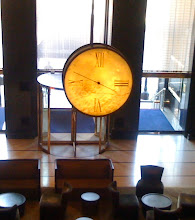Dennis Overbye writes in The New York Times:
Physicists had been icing the Champagne ever since last December. Two teams of about 3,000 physicists each — one named Atlas, led by Fabiola Gianotti, and the other CMS, led by Dr. Incandela — operate giant detectors in the collider, sorting the debris from the primordial fireballs left after proton collisions.
Last winter, they both reported hints of the same particle. They were not able, however, to rule out the possibility that it was a statistical fluke. Since then, the collider has more than doubled the number of collisions it has recorded.
The results announced Wednesday capped two weeks of feverish speculation and Internet buzz as the physicists, who had been sworn to secrecy, did a breakneck analysis of about 800 trillion proton-proton collisions over the last two years.
Up until last weekend, physicists at the agency were saying that they themselves did not know what the outcome would be. Expectations soared when it was learned that the five surviving originators of the Higgs boson theory had been invited to the CERN news conference.
The December signal was no fluke, the scientists said Wednesday. The new particle has a mass of about 125.3 billion electron volts, as measured by the CMS group, and 126 billion according to Atlas. Both groups said that the likelihood that their signal was a result of a chance fluctuation was less than one chance in 3.5 million, “five sigma,” which is the gold standard in physics for a discovery.
On that basis, Dr. Heuer said that he had decided only on Tuesday afternoon to call the Higgs result a “discovery.”
He said, “I know the science, and as director general I can stick out my neck.”
Dr. Incandela’s and Dr. Gianotti’s presentations were repeatedly interrupted by applause as they showed slide after slide of data presented in graphs with bumps rising like mountains from the sea.
Dr. Gianotti noted that the mass of the putative Higgs, apparently one of the heaviest subatomic particles, made it easy to study its many behaviors. “Thanks, nature,” she said.
From Overbye's blog post, What in the World Is a Higgs Boson?
Last winter Lisa Randall, a prominent Harvard theorist, sat down with me in a sort of virtual sense to talk about this quest. Everything she said is still true.
Q.
In 1993, the United States Congress canceled a larger American collider, the superconducting super collider, which would have been bigger than the CERN machine. Would it have found the Higgs particle years ago?
A.
Yes, if it had gone according to schedule. And it would have been able to find things that weren't a simple Higgs boson, too. The Large Hadron Collider can do such searches as well, but with its lower energy the work is more challenging and will require more time.
- Posted using BlogPress from my iPad

No comments:
Post a Comment